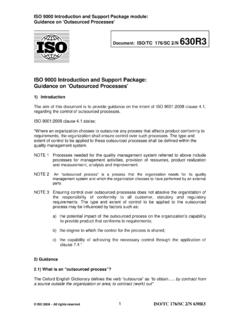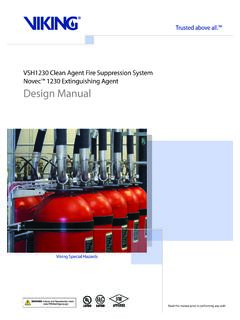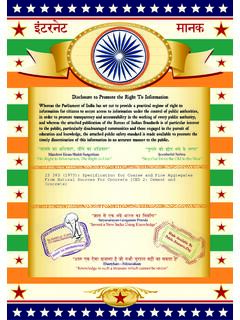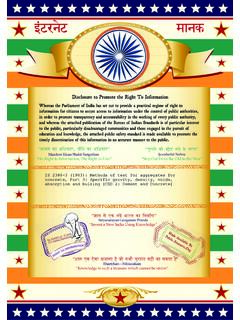Transcription of ICS - International Organization for Standardization
1 ICSI nternational Classificationfor Standardsedition 7 International Classification for Standards 2015 | 1 International Classification for StandardsIntroduction ..3 Purpose of the ICS ..3 Description of the ICS ..3 Rules for the use of the ICS .. 5 Updating of the ICS ..11 How to use the ICS index ..11 List of the ICS fields ..12 Systematic table of fields, groups and sub-groups ..15 International Classification for Standards, 2015 Seventh editionISBN 978-92-67-10652-6 International Organization for StandardizationInternational Classification for Standards 2015 | 3 Introduction1 - Purpose of the The ICS ( International Classification for Standards) is intended to serve as a structure for catalogues of International , regional and national standards and other normative doc-uments, and as a basis for standing-order systems for International , regional and national standards.
2 It may also be used for classifying standards and normative documents in data-bases, libraries, The ICS should facilitate the harmonization of information and ordering tools such as catalogues, selective lists, bibliographies, and databases on magnetic and optical media, thus promoting the world-wide dissemination of International , regional and national stand - ards and other normative - Description of the For the purposes of this document, the general term standard is applied to all inter-national, regional and national normative documents, such as standards, technical reports, standardized profiles, technical specifications, technical regulations, guides, codes of practice, technology trends assessments, etc.
3 And the drafts of such The ICS is a hierarchical classification which consists of three Level 1 covers 40 fields of activity in Standardization , road vehicle engineering, agriculture, metallurgy. Each field has a two-digit notation, ROAD VEHICLE The fields are subdivided into 392 groups (level 2). The notation of a group consists of the field notation and a three-digit group number, separated by a point, Road vehicle 144 of the 392 groups are further divided into 909 sub-groups (level 3). The notation of a sub-group consists of the group notation and a two-digit number, separated by a point, Lighting, signalling and warning A number of group and sub-group titles are followed by scope notes and/or reference notes, indicated by asterisks and printed in italics in the ICS.
4 A scope note, as a rule, lists subjects covered by a given group/sub-group or defines the subject of a given group/sub-group. A reference note refers to a subject, related to a given group/sub-group, which is covered by another | International Classification for Standards All groups divided into sub-groups contain, with a few exceptions, a sub-group which covers the complete subject of the respective group. Such general subject sub-groups have notations terminating with .01 . For example, the Microbiologycontains as a first Microbiology in generalwhich shall include standards covering the subject of microbiology in general, the standardISO 21528-1:2004, Microbiology of food and animal feeding stuffs Horizontal methods for the detection and enumeration of Enterobacteriaceae Part 1.
5 Detection and enumeration by MPN technique with pre-enrichmentwhile standards covering medical microbiology, microbiology of water, food microbiology or cosmetics microbiology shall be included respectively in other specific sub-groups : , , or Most of the groups divided into sub-groups contain a sub-group having the notation terminating with .99 . Such sub-groups include standards on subjects which do not cor-respond either to the subjects of the general sub-groups or to the subjects of the specific sub-groups of the respective groups.
6 For example, the subject of the standardISO 10945:1994, Hydraulic fluid power Gas-loaded accumulators Dimensions of gas portsdoes not correspond either to the subject of the Fluid power systems in generalor to the specific subjects of the Pumps and Piping and Control Filters, seals and contamination of fluidsIn this case, it shall be included in the Other fluid power system componentsThe above rule does not apply in the ICS if all standards related to a group can be included either in the general sub-group or in the specific example.
7 The Bearingscontains the general subject Bearings in generaland specific Plain bearings International Classification for Standards 2015 | Rolling bearingsThe group does not contain a Other bearingssince all bearings belong only to two types of bearings : plain bearings and rolling - Rules for the use of the The latest edition of the ICS with the subsequent issues of the ICS Update should be used for indexing standards and other normative documents and their drafts. Before indexing standards for the first time, the indexer should first carefully study the present rules and the ICS Standards should be classified according to their subjects.
8 The indexer should first identify the appropriate field for a given subject, then allocate the appropriate group notation, and, further, the sub-group s notation if the group is subdivided. For example, the standardISO 3412:1992, Road vehicles Screened and waterproof spark-plugs and their connections Types 1A and 1 Bbelongs to the field43 ROAD VEHICLE ENGINEERINGThe appropriate group within the field Internal combustion engines for road vehiclesand the appropriate sub-group within the group Electrical equipment. Control systemsIf the field of application of a standard is not clear from its content, indexers may take into account the scopes of the relevant technical committee, subcommittee and working group responsible for the development of the The alphabetical index of the ICS may be used as a supplementary tool for identifying the appropriate field, group, sub-group, but the notations found in the index shall be carefully verified against the systematic table.
9 The reason is that only the systematic table contains the full information relating to a group notation, such as its title, the field to which it belongs, the subdivision into sub-groups, sometimes the scope note, and the reference note(s) showing its relationship with other group(s) or sub-group(s). Otherwise errors in indexing may It is recommended to use all levels available for classifying a given standard. For exam-ple, the standardsISO 5358:1992, Anaesthetic machines for use with humansISO 7864:1993, Sterile hypodermic needles for single useISO 7740:1985, Instruments for surgery Scalpels with detachable blades Fitting dimensionsshould be classified respectively in sub-groups , and (level 3).
10 It is not recommended to allocate notation (level 2) to the above standards since it may create difficulties in the exchange of ICS data between databases and will impede application of the ICS in multinational information | International Classification for Standards Standards classified according to this classification may be included in more than one group or sub-group ; the standardISO 7686:2005, Plastics pipes and fittings Determination of opacityshall be included in the two Plastics Plastics fittingswhile the standardISO 8159.


















